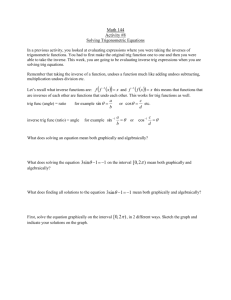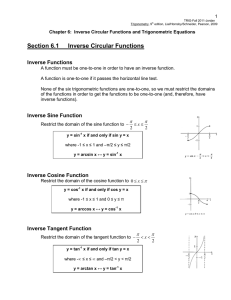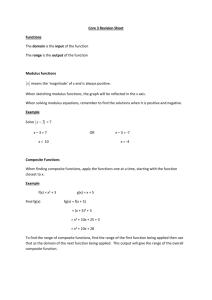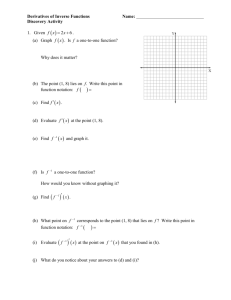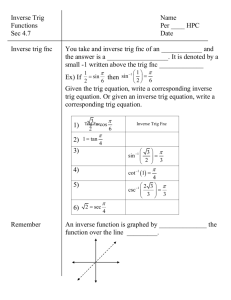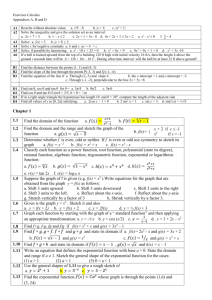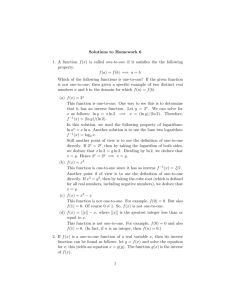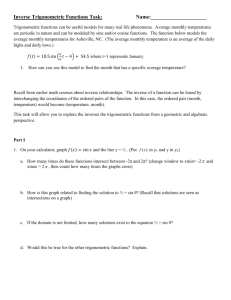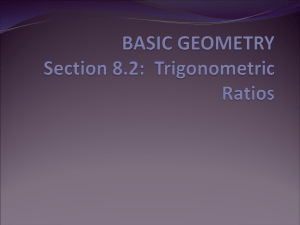Trig 13.4 Inverse Functions
advertisement
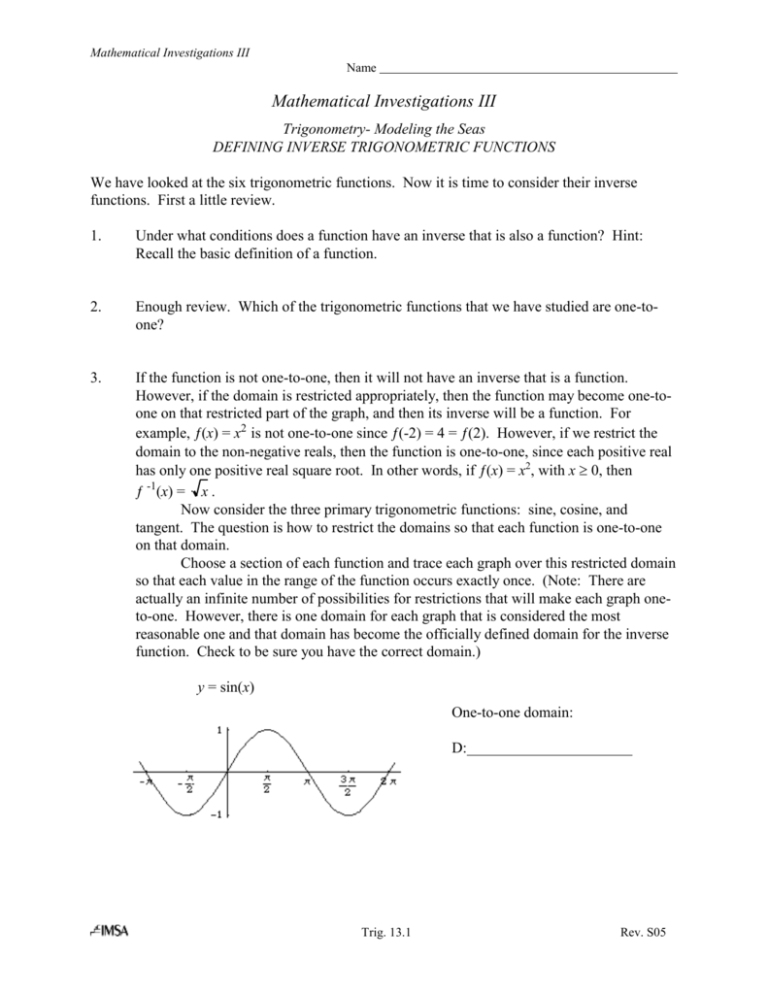
Mathematical Investigations III Name Mathematical Investigations III Trigonometry- Modeling the Seas DEFINING INVERSE TRIGONOMETRIC FUNCTIONS We have looked at the six trigonometric functions. Now it is time to consider their inverse functions. First a little review. 1. Under what conditions does a function have an inverse that is also a function? Hint: Recall the basic definition of a function. 2. Enough review. Which of the trigonometric functions that we have studied are one-toone? 3. If the function is not one-to-one, then it will not have an inverse that is a function. However, if the domain is restricted appropriately, then the function may become one-toone on that restricted part of the graph, and then its inverse will be a function. For example, ƒ(x) = x2 is not one-to-one since ƒ(-2) = 4 = ƒ(2). However, if we restrict the domain to the non-negative reals, then the function is one-to-one, since each positive real has only one positive real square root. In other words, if ƒ(x) = x2, with x 0, then ƒ -1(x) = x . Now consider the three primary trigonometric functions: sine, cosine, and tangent. The question is how to restrict the domains so that each function is one-to-one on that domain. Choose a section of each function and trace each graph over this restricted domain so that each value in the range of the function occurs exactly once. (Note: There are actually an infinite number of possibilities for restrictions that will make each graph oneto-one. However, there is one domain for each graph that is considered the most reasonable one and that domain has become the officially defined domain for the inverse function. Check to be sure you have the correct domain.) y = sin(x) One-to-one domain: D: Trig. 13.1 Rev. S05 Mathematical Investigations III Name y = tan(x) One-to-one domain: D: y = cos(x) One-to-one domain: D= It is important to pause and take a note of the notation, specifically designed to confuse the unwary. sin-1(a) means the inverse function, not the reciprocal function. Thus, sin-1(a) = b means that sin(b) = a. What should you write to express 1/sin(x) ? 4. How do the solutions to the following equations differ? (i) sin(x) = 0.5 (ii) x = sin-1(0.5) Trig. 13.2 Rev. S05 Mathematical Investigations III Name 5. Below are the graphs of y = sin-1(x), y = cos-1(x), and y = tan-1(x). Graph each on your calculator (to see how your calculator displays them), then label each graph below correctly and give its domain and range. y= y= D= D= R= R= y= D= R= 6. Now you try it. Give the exact value of the following. [Note: You should be able to complete these problems without using a calculator. To find sin-1(k), ask yourself, “What angle, within the proper domain, has a sine of k?”] 1 sin 1 = 2 sin1 (0) = Trig. 13.3 3 sin 1 = 2 Rev. S05 Mathematical Investigations III Name 6. (Continued.) Evaluate. cos1 (1) = tan1 3= 1 cos 1 = 2 3 cos1 = 2 2 cos1 = 2 3 tan 1 = 3 tan 1 (1) = 1 sin 1 = 2 1 cos 1 = 2 If we make some fairly natural decisions about domain restrictions we can also determine graphs and values for the inverses of reciprocal functions. The principal value range for sec 1 (x) is (usually!) similar to that of cos1 (x) . That is, it uses the same quadrants. What is range of y sec1 (x) ? The principal value range for csc 1 (x) is similar to that of sin1 (x) . The principal value range for cot 1 (x) is 0 x so that the graph is connected. 7. Use this information to find exact values for each of the following. sec1 (2) 8. csc1 2 Sketch. Mark your scales carefully. a. y 2sin 1 (x) cot 1 b. Trig. 13.4 3 y sin 1 (2x) Rev. S05
